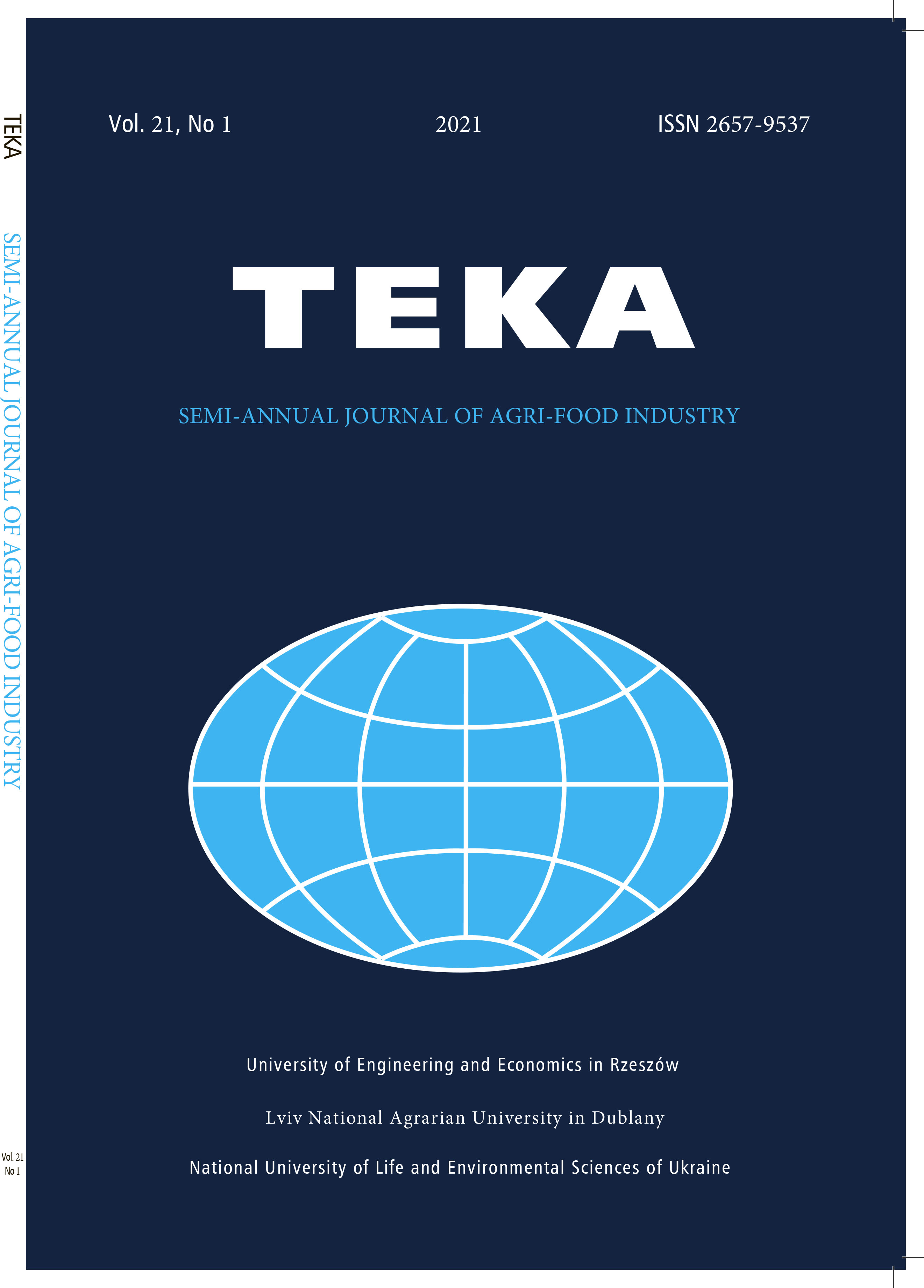NVESTIGATION OF DIMENSIONAL CHARACTERISTICS OF PEA AND MILLET GRAIN
Keywords:
variability of grain size characteristics, width, thickness, length, peas, millet, halves of peas, average equivalent diameter, shapeAbstract
Crop yields have been significantly affected by arid weather over the past five years. They lead not only to a
decrease in crop yields, but also to a decrease in the quality of the crop grown. First of all, its grain part includes a
considerable amount of soft underdeveloped grain with a total weight reduction of 1000 seeds of the main crop. Postharvest treatment of the grain part of such a crop is associated with the separation of part of the grain of the main
crop into waste fractions. The content of these fractions, after appropriate refinement, can be a valuable component
of the feed and feed additives required for the complete feeding of farm animals. To obtain balanced and nutritional
nutritious feeds, it is necessary to have finely ground with small particle sizes of all components and their particle
size distribution. The process of grinding by rotary shredder is promising. To substantiate the parameters of such
shredders and to choose the modes of their operation requires a thorough study of the mechanical and technological
properties of all components of the original grain materials, including their size and shape. The variability of grain
sizes was estimated by its geometric dimensions: thickness, width and length, their statistical characteristics and
equivalent diameter. The sampling volume of each grain was 100 units for reliable results. Separate whole grains of
peas and millet and the characteristic halves of peas were studied. Studies of the dimensional characteristics of the
grain of the pea of the Motto variety, its halves and the grain of millet Slobozhanske found that their average values
of length, width and thickness differ significantly and the standard deviation of their thickness 1.33 mm, width –
1.47 mm, and lengths – 1, 51 mm. The coefficient of variation of the length of the studied grain is 34.40%, width
– 39.73%, and thickness – 47.33%. The average equivalent diameter of the studied grain varies from 2.52 mm grains
of Slobozhanske millet to 7.20 mm grains of Motto pea. The smallest weight of 1000 pieces also has millet grain –
7.54 g, and the largest – pea grain – 258.77 g.
References
Hnoyevyy V. I., Lebedynsʹkyy V. I. 2018. Dobrobutko
rivnamolochnykh fermakh : Operatyvn apolihrafiya.
FOP Zdorovyy Y A. A., 248 s (in Ukraine).
Kumhalova J., Kumhala F., Kroulik M., Matejkova S.
Muasya R. M., Lommen W. J. M., Muui C. W.,
Struik P. C. 2008. How weather during
development of common bean (Phaseolus vulgaris
L.) affects the crop's maximum attainable seed
quality. Njas-wageningen journal of life sciences.
Vol. 56. № 1-2. P. 85-100. DOI10.1016/S1573-
(08)80018-8 (in Ukraine).
Normyhodivli, ratsiony i pozhyvnistʹ kormiv dlya
riznykh vydiv silʹsʹkohospodarsʹkykh tvaryn:
[dovidky]. Provatorov S. V., Ladyka V. I.,
Bondarchuk L. V. Sumy: TOV VTD
Universytet·sʹkaknyha, 2007. 488 s (in Ukraine).
Soto-Navarro S. A., Encinias A. M., Bauer M. L.,
Lardy G. P., Caton J. S. 2012. Feedingvalueoffield peaas a proteinsourcein forage-baseddietsfedto
beefcattle. Journalofanimalscience. Vol. 90. № 2.
P. 585-591. DOI10.2527/jas.2011-4098 (in
Ukraine).
Khorasani G. R., Okine E. K., Corbett R. R.,
Kennelly J. J. 2001. Nutriti vevalueof peasforlact
atingdairycattle. Canadian journal
ofanimalscience. Vol. 81. № 4. P. 541-551. DOI
4141/A01-019 (in Ukraine).
Nutritional evaluationof grainand strawfraction
sofpeagenotypesg rownunder aridconditions.
Bingol N. T., Bolat D., Levendoglu T., Togay Y.,
Togay N. Journal of applied animal research. 2008.
Vol. 33. № 1. P. 93-97. DOI
1080/09712119.2008.9706905 (in Ukraine).
Wadhwa M. D., Paul P., Kataria M. P. S., Bakshi Е. Р.
Effect of particle size of сorn grain
sontherele ase of nutri entsandins accodegra
dability. Animal feedscienceandtechnology. Vol.
№ 1-2. P. 11-17. DOI 10.1016/S0377-
(97)00185-5 (in Ukraine).
Revenko I. I., Revenko I. I., Brahinetsʹ M. V.,
Ryabenko V. I. Mashynyt aobladn an nyadlyatva
rynnytstva. K.: Kondor, 2009. 730 s (in Ukraine).
Syrotyuk V. M. Mashyny ta obladnannyadly
atvarynnytstva. Lʹviv: Mahnoliyaplyus, 2004.
s.
Patent Ukrayiny № 95760, MPK V02S18/04. Sposib
podriblennya furazhnoho zerna. Nanka O. V. Opubl.
01.2015, Byul. №1. 3 s (in Ukraine).
Nanka O. V. Doslidzhennya mekhanikotekhnolohichnykh vlastyvostey zernasoyi.
Mekhanizatsiya silʹsʹkoho spodarsʹkoho
vyrobnytstva: visnyk KHNTUS·H, Vyp. 190.
Kharkiv, 2018. S. 130-138 (in Ukraine).
Patent Ukrayiny № 131348, MPK V02S9/02. Frezernyy
podribnyuvach zerna / Nanka O. V.,
Naumenko O. A., Bakum M. V. Opubl.
01.2019, Byul. № 1. 6 s (in Ukraine).
Nanka O., Boyko I. 2013. Analitical researches of
method sand construction of grinders of corn
forage. Motrol. Commission of Motorization and
Energetics in Agriculture. Lublin, Vol. 15. № 7. P.
-9 (in Poland).
Mekhaniko-tekhnolohichni vlastyvostisil
sʹkohospodarsʹkykh materialiv: Pidruchnyk/
Tsarenko O. M., Voytyuk D. H., Shvayko V. M.,
Dovzhyk M. Y A., Yatsun S. S.; za red.
S.S. Yatsuna. K.: Meta, 2003. 448 s (in Ukraine).

